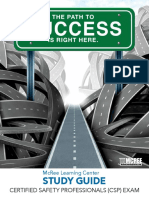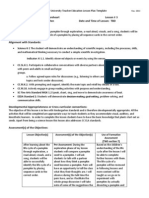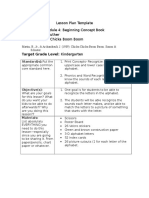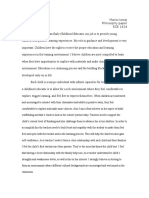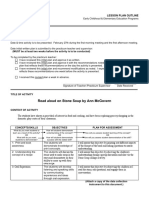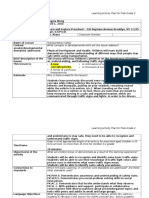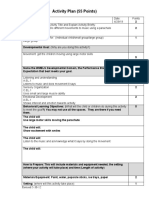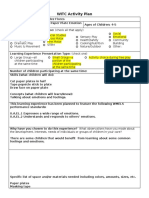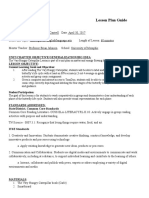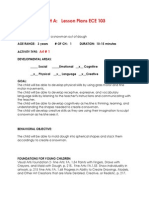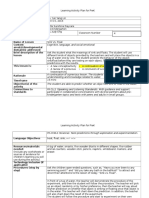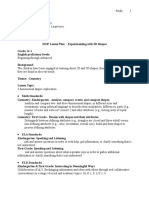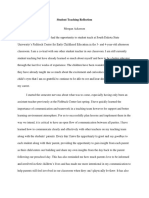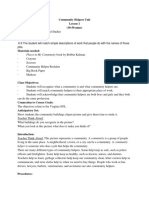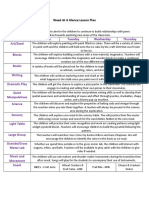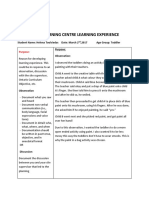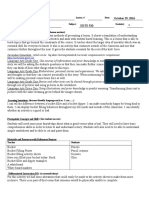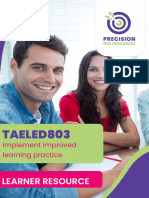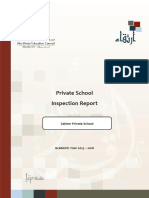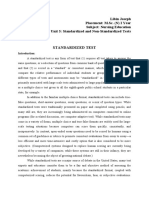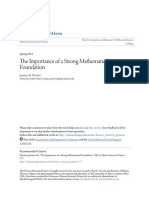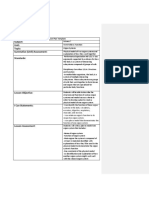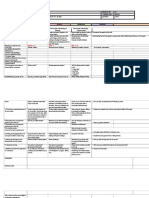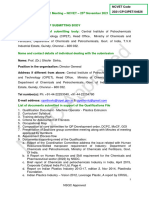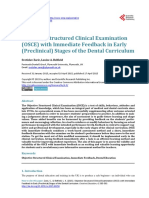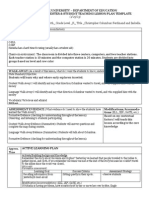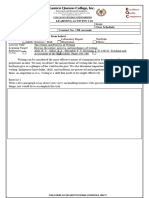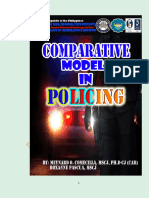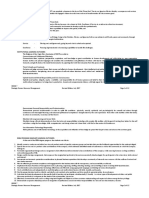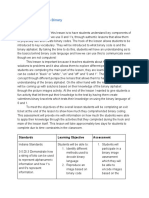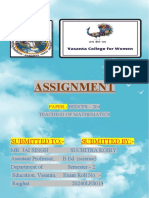Ecc 70300 - Pre-K Lesson Plan 3
Ecc 70300 - Pre-K Lesson Plan 3
Uploaded by
api-319345441Copyright:
Available Formats
Ecc 70300 - Pre-K Lesson Plan 3
Ecc 70300 - Pre-K Lesson Plan 3
Uploaded by
api-319345441Original Title
Copyright
Available Formats
Share this document
Did you find this document useful?
Is this content inappropriate?
Copyright:
Available Formats
Ecc 70300 - Pre-K Lesson Plan 3
Ecc 70300 - Pre-K Lesson Plan 3
Uploaded by
api-319345441Copyright:
Available Formats
Learning Activity Plan for PreK-Grade 2
Teacher Candidate
Date/Time of Scheduled
Visit
Name/Address of School
Age/Grade level
Cooperating Teacher
Angela Wong
April 23, 2016
Name of Lesson
Content
area(s)/developmental
domain(s) addressed
Patterning Seeds
What concepts or developmental skills will this lesson address?
Brief description of the
lesson
This lesson is:
Rationale
Timeframe
Learn and Explore Preschool 330 Neptune Avenue Brooklyn, NY 11235
Age 4-5/Pre-K
Ms. Alana
Classroom Number
Mathematics: Children will demonstrate an understanding of the
concept of patterning and continued repetition.
This lesson will focus childrens attention on the repetition of core units
of different types of patterns.
A new concept/activity A continuation of a previous lesson/activity
A review of a previous A conclusion of a concept
lesson/activity
Why is there a need for this lesson?
Patterning is an important part of mathematics, but it also promotes
the development of one's ability to recognize the order of occurrences,
as well as to make predictions about what will come next. By
understanding patterns using concrete objects such as beans and
seeds, children will be better prepared to identify patterns in ideas (i.e.
storybooks), words (i.e. rhymes), numbers (i.e. counting), and more.
Keep in mind appropriate length of an activity for preschool-aged children is 20
mins at most, no more than 45 mins for children K-2 grade)
Learning Activity Plan for PreK-Grade 2
20 minutes
Objective(s) of the
activity
Connections to
standards
Language Objectives
What will children know, or demonstrate as a result of this learning experience?
- Students will understand that seeds are planted in rows.
- Students will be able to use their pincher grasps to manipulate small
objects.
- Students will be able to differentiate between different beans and
seeds.
- Students will be able to use beans and seeds to extend and create
their own patterns.
Which NYS Early Learning, or Common Core Standards are addressed? Are there
other standards used?
PK.PDH.5. Demonstrates eye-hand coordination and dexterity needed
to manipulate objects.
PK.CKW.2 (Operations and Algebraic Thinking). Duplicate and extend
(e.g., what comes next?) simple patterns using concrete objects.
PK.CKW.2 (Measurement and Data). Sort objects into categories; count
the numbers of objects in each category (limit category counts to be
less than or equal to 10).
PK.SL.1. With guidance and support, participate in collaborative
conversations with diverse partners about pre-kindergarten topics and
texts with peers and adults in small and large groups.
What language/vocabulary, communication, or literacy skill(s) do I want my
students to develop in this lesson? For edTPA consider this: Which academic
language demands am I targeting? Choose one, including language functions,
vocabulary, syntax, or discourse that is central to this learning segment. How is
this activity using the specific language demand?
Learning Activity Plan for PreK-Grade 2
For this lesson, we will be focusing primarily on building vocabulary and
communicating their work to others. Children will recognize and label
the names of familiar seeds and/or beans such as lima beans, red
beans, soybeans, black beans, sunflower seeds, marigold seeds,
pumpkin seeds, and apple seeds.
Resources/materials
needed:
(Include any worksheets or
sources of evidence for
childrens learning you will
use during the activity)
Technology inclusion (if
applicable)
Procedures (step by
step)
- Self-constructed pretend garden rows (made from paper towel rows)
- Chart paper
- Markers
- Zinnia's Flower Garden by Monica Wellington
- Various beans (i.e. lima beans, black beans, red beans, soybeans)
- Various seeds (i.e. sunflower seeds, marigold seeds, pumpkin seeds,
apple seeds)
- Laminated soil pattern sheets
N/A
Anticipatory Set (Connection/Motivation) What will you do to get childrens
attention, or to introduce children to this learning activity? Describe the process
in getting them interested and engaged.
We have already learned that specific seeds grow into specific plants
(i.e. carrot seeds grow into carrots; orange seeds grow into oranges,
etc.). In our Blocks Center (also known as our garden), there are
portable garden rows made from boxes and paper towel rolls. Taking
that to the rug for Circle Time, I will demonstrate for the class how I
plant seeds into the rows. Next, I will have some volunteers come up
to help plant some seeds as well. This will strengthen the concept
that like the seeds, patterns follow one after the other.
Learning Activity Plan for PreK-Grade 2
Instruction/Mini Lesson (Outline the procedures or sequence activities that will
make up this learning experience; for instance, you might follow a routine
wherein you model (I try); and ask for active involvement (we try) during a whole
group session.
- I will read Zinnia's Flower Garden by Monica Wellington.
- Afterwards, I will tell the children that people are the ones who decide
where to plant their seeds, and how to plant them. While normally,
gardeners and farmers plant the same seeds in the same row, we will
try to make patterns with our seeds.
- I will explain that patterns always repeat the same way over and over
again.
- On chart paper, I will draw a line going across the page to represent a
garden row. Next, I will create an AB pattern using two different colored
markers (i.e. black and pink). Using a red marker, I will draw a box
around it to emphasize that those colors will repeat themselves in the
same order, over and over again.
- Then, I will extend the pattern one time, and then once more, while
asking the class for their suggestions on what color they think should
come next.
- I will call on volunteers to continue to extend the pattern until the end
of the garden row is reached.
- Next, I will make a new row of seeds with an AABB pattern using the
same seeds, and repeat the process of extending it once, and then
calling on volunteers to demonstrate as well.
Independent Practice (small group activity, working with partners, or
independently)
During Center Time, students in small groups will be given a laminated
Learning Activity Plan for PreK-Grade 2
picture with four garden rows with pre-determined core units for 3
various patterns. Using their given seeds and/or beans, they will
duplicate and extend their patterns. In the last row, they will create
their own patterns.
Closure (sharing/reflection, next steps)
In their small groups, students will partner up and take turns sharing
out their seed and/or bean patterns.
Method of assessing
childrens
understanding of
lesson/activity/objective
(s)
(Be sure to include any
tools, rubrics/checklists
and/or worksheets you will
use for assessment(s)
Pre-assessment
Outline the steps you will
take to evaluate
students prior
knowledge.
In the Blocks Center,
prompt children to
choose two blocks
with which to build
towers out of. How tall
can they make it
before it falls down?
(Even if the towers
fall, children can still
be observed to see
whether or not they
know which
appropriate block will
come next.)
Assessment of Student
Learning Outline the steps
you will take to evaluate
students learning. What
evidence will I have to
assess whether students
have successfully achieved
the content objectives?
Put out different
patterning sheets with a
wide variety of seeds
and beans in the Math
Center. Observe children
to see if they are able to
extend and/or create a
variety of patterns.
Assessment of
Childrens Language
Learning
Outline the steps you
will take to evaluate
students language
learning. What
evidence will I have to
assess whether
students have
successfully achieved
the content objectives?
Review different
patterns and have
students extend
them using various
manipulatives (i.e.
linking cubes,
counters, etc.).
Learning Activity Plan for PreK-Grade 2
Plans for differentiated
instruction/instructional
modifications
Supporting children
with identified delays
or disabilities
What considerations
should I keep in mind
regarding cultural
relevance, age
appropriateness, and
ability levels for all
learners?
When supporting
children with
identified delays or
disabilities, I will give
them extra time to
complete their tasks,
along with more
guidance,
encouragement, and
support. Children can
pair up with a partner
if they are having
difficulties, and can
create more difficult
patterns to match
their own ability
levels.
Supporting English Language Learners
What modifications should I make to the activity to
ensure all students are included and engaged in all
steps required to meet the lessons objectives?
To ensure that all students are included and
engaged in all the steps that are required to
meet the lessons objectives, I will use picture
cues with labels. There will be a lot of oral
repetition. Children who have difficulty labeling
the specific seeds will be paired up with a
partner within the small group, who can help
guide them as they make and share their
patterns.
Learning Activity Plan for PreK-Grade 2
Follow up/Extension
activities
How can I provide an opportunity to remediate, reinforce, or expand on students
learning today in class?
- In the Sensory Table (changed from Water and Sand Tables into Soil
Tables), children can plant their seeds and beans in rows in the soil to
make patterns.
- In large containers, children can help to plant real seeds and beans in
patterns. As they care for their plants by watering them and making
sure they are exposed to direct sunlight and fresh air, they will begin to
see the difference between the plants sprouts. To extend this from
math to science, students can draw their observations of the rows of
patterned plants.
Any additional
information that would
be helpful for the
observer to know
Observer feedback on the lesson plan, including commendations and recommendations for improving aspects
of the learning activity
You might also like
- Certified Safety Professionals (CSP) Exam Study GuideDocument20 pagesCertified Safety Professionals (CSP) Exam Study GuideMcRee Learning Center60% (10)
- Lesson Plan 3 Pumpkin Life CycleDocument3 pagesLesson Plan 3 Pumpkin Life Cycleapi-177768681No ratings yet
- Apple Math LessonDocument12 pagesApple Math Lessonapi-495904597No ratings yet
- Short Vowel Prek Lesson PlanDocument6 pagesShort Vowel Prek Lesson Planapi-605820842No ratings yet
- Eced 303 Toolkit FinalDocument24 pagesEced 303 Toolkit Finalapi-574583866No ratings yet
- Lesson Plan Weebly 2jeDocument5 pagesLesson Plan Weebly 2jeapi-258457840No ratings yet
- Literacy Lesson PlanDocument4 pagesLiteracy Lesson PlanAnnie Jeannette Garza0% (1)
- Ece232 Iters AssignmentDocument6 pagesEce232 Iters Assignmentapi-356490441No ratings yet
- Lesson Plan CountingDocument4 pagesLesson Plan Countingapi-307403301No ratings yet
- Self Assessment Preschool Teaching PracticesDocument3 pagesSelf Assessment Preschool Teaching Practicesapi-497849152No ratings yet
- Pompom Colour SortingDocument6 pagesPompom Colour Sortingapi-349800041100% (1)
- Chicka Chika Boom Boom Lesson PlanDocument3 pagesChicka Chika Boom Boom Lesson Planapi-356615131100% (1)
- Ece Philosophy PaperDocument3 pagesEce Philosophy Paperapi-349448402100% (2)
- QCTO - Truck DriverDocument6 pagesQCTO - Truck DriverMichael NcubeNo ratings yet
- EAPP DLLDocument2 pagesEAPP DLLJay-Ar Mario100% (17)
- The Very Hungry CaterpillarDocument3 pagesThe Very Hungry Caterpillaralesejohnson3No ratings yet
- Pattern Lesson Plan 11Document13 pagesPattern Lesson Plan 11huda hamadNo ratings yet
- 14 Oct PlanDocument4 pages14 Oct Planapi-223120833No ratings yet
- Stone Soup Read Aloud Lesson PlanDocument4 pagesStone Soup Read Aloud Lesson Planapi-346175167No ratings yet
- Ecc 70300 - Pre-K Lesson Plan 1Document7 pagesEcc 70300 - Pre-K Lesson Plan 1api-319345441100% (1)
- Lily Pad Hop Activity PlanDocument5 pagesLily Pad Hop Activity Planapi-500025821No ratings yet
- Activity Plan Music and MovementDocument2 pagesActivity Plan Music and Movementapi-497850938100% (1)
- Lesson Plan 2 - The Hungry CaterpillarDocument4 pagesLesson Plan 2 - The Hungry Caterpillarapi-2577118020% (1)
- Lesson Plan 3Document7 pagesLesson Plan 3api-547693363No ratings yet
- Lesson Plan March 12th-15thDocument9 pagesLesson Plan March 12th-15thapi-443527010No ratings yet
- Social Language Activity PlanDocument5 pagesSocial Language Activity Planapi-490919939No ratings yet
- Child PortfolioDocument4 pagesChild Portfolioapi-283943637100% (1)
- Key Assessment 1 Observation and Interpretation p56-62Document7 pagesKey Assessment 1 Observation and Interpretation p56-62api-215636357No ratings yet
- BYU-Idaho Preschool Lesson Plan Lesson Plan #8: Lab 4 InsectsDocument9 pagesBYU-Idaho Preschool Lesson Plan Lesson Plan #8: Lab 4 Insectsapi-400179769No ratings yet
- Fine Motor Lesson PlanDocument2 pagesFine Motor Lesson Planapi-334092157No ratings yet
- Lesson - Plan - The Four Rs of Recycling PDFDocument11 pagesLesson - Plan - The Four Rs of Recycling PDFbismaNo ratings yet
- If You Give A Moose A MuffinDocument25 pagesIf You Give A Moose A Muffinapi-373177666No ratings yet
- Anisa Branch 703Document6 pagesAnisa Branch 703api-535374046No ratings yet
- Math - Counting Numbers Lesson PlanDocument3 pagesMath - Counting Numbers Lesson PlanNicole dundonNo ratings yet
- Kindergarten ObservationDocument5 pagesKindergarten Observationapi-534364006No ratings yet
- Day 9 - Field Practicum 3 Responsive Planning TemplateDocument2 pagesDay 9 - Field Practicum 3 Responsive Planning Templateapi-239582310No ratings yet
- Color Word Lesson 2Document2 pagesColor Word Lesson 2api-340401996100% (1)
- Sorting Lesson PlanDocument4 pagesSorting Lesson Planapi-267077176No ratings yet
- Lesson PlansDocument12 pagesLesson Plansapi-613761000No ratings yet
- Reece Final Case StudyDocument15 pagesReece Final Case Studyapi-501003650No ratings yet
- Floor Plan and Iters GradingDocument5 pagesFloor Plan and Iters Gradingapi-510112249No ratings yet
- Edt 317 - Visual Arts Lesson PlanDocument3 pagesEdt 317 - Visual Arts Lesson Planapi-660829902No ratings yet
- Ers Narrative RevisedDocument7 pagesErs Narrative Revisedapi-596349166No ratings yet
- Edtpa Lesson Plan 2 Cantrell DeborahDocument5 pagesEdtpa Lesson Plan 2 Cantrell Deborahapi-349585089No ratings yet
- Lesson Plans Ece 103Document8 pagesLesson Plans Ece 103api-216183591100% (1)
- Wooden Puzzle Number MatchingDocument4 pagesWooden Puzzle Number Matchingapi-347621730No ratings yet
- Shapes Lesson Plan Semester 3Document3 pagesShapes Lesson Plan Semester 3api-296901996No ratings yet
- Reflection For Preschool Lesson 1Document4 pagesReflection For Preschool Lesson 1api-535311838No ratings yet
- Ecc Prek-2 Lesson Plan Template Final 1Document5 pagesEcc Prek-2 Lesson Plan Template Final 1api-319439832No ratings yet
- Section 2 - WeeblyDocument13 pagesSection 2 - Weeblyapi-469406995No ratings yet
- Assessment - SIOP Lesson Plan Final - ReidyDocument7 pagesAssessment - SIOP Lesson Plan Final - ReidyGinaNo ratings yet
- Running Head: School Wide Literacy Plan 1Document10 pagesRunning Head: School Wide Literacy Plan 1api-548263927No ratings yet
- Preschool Student Teaching ReflectionDocument3 pagesPreschool Student Teaching Reflectionapi-568700214No ratings yet
- Social Studies Unit Plan-KindergartenDocument13 pagesSocial Studies Unit Plan-Kindergartenapi-355062161No ratings yet
- Toddler Preplan-HighlightedDocument11 pagesToddler Preplan-Highlightedapi-393899761No ratings yet
- Read Aloud LessonDocument6 pagesRead Aloud Lessonapi-346175193No ratings yet
- Lesson Plan For WeeblyDocument11 pagesLesson Plan For Weeblyapi-379240242100% (2)
- Week Beginning 01.10.2012Document3 pagesWeek Beginning 01.10.2012brightelcsunshineNo ratings yet
- Kindergarten Shape Unit Lesson PlanDocument28 pagesKindergarten Shape Unit Lesson Planapi-214770001No ratings yet
- Music Activity PlanDocument4 pagesMusic Activity Planapi-506346106No ratings yet
- Paint Bag ActivityDocument5 pagesPaint Bag Activityapi-347621730No ratings yet
- Bucket Filling Lesson PlanDocument3 pagesBucket Filling Lesson Planapi-339699911No ratings yet
- No Biting, Third Edition: Solutions and Support for Toddler ProgramsFrom EverandNo Biting, Third Edition: Solutions and Support for Toddler ProgramsNo ratings yet
- Understanding The Impact of Covid-19 On Education Symbiosis Law School, PuneDocument26 pagesUnderstanding The Impact of Covid-19 On Education Symbiosis Law School, PuneSrijan NetiNo ratings yet
- Evaluation DashboardDocument4 pagesEvaluation DashboardSuresh kumarNo ratings yet
- 21st Century Education ContextsDocument15 pages21st Century Education ContextsJazz AcostaNo ratings yet
- Educ450 lp1 Extrema Plan ExpandedDocument5 pagesEduc450 lp1 Extrema Plan Expandedapi-295344110No ratings yet
- On Site Assessment TemplateDocument8 pagesOn Site Assessment TemplatewentropremNo ratings yet
- TAELED803 Learner ResourceDocument146 pagesTAELED803 Learner ResourceShaun SandersNo ratings yet
- TsinaDocument63 pagesTsinaMario Carbonel Jr.No ratings yet
- ADEC - Zakher Private School 2015 2016Document28 pagesADEC - Zakher Private School 2015 2016Edarabia.comNo ratings yet
- Standardized TestDocument5 pagesStandardized Testtanmai nooluNo ratings yet
- The Importance of A Strong Mathematical FoundationDocument39 pagesThe Importance of A Strong Mathematical FoundationJessabelle AbeloNo ratings yet
- Lesson Plan 3Document4 pagesLesson Plan 3api-362351442No ratings yet
- #2teaching and Assessment of GrammarDocument17 pages#2teaching and Assessment of GrammarDongLei CortezNo ratings yet
- Mapeh DLL 2nd QTR Week 2Document3 pagesMapeh DLL 2nd QTR Week 2Sherwin Anoba CabutijaNo ratings yet
- Qualification File - Machine Operator Plastics Extrusion - L4-MopeDocument21 pagesQualification File - Machine Operator Plastics Extrusion - L4-MopeSTC CIPETNo ratings yet
- Objective Structured Clinical Examination (OSCE) With Immediate Feedback in Early (Preclinical) Stages of The Dental CurriculumDocument9 pagesObjective Structured Clinical Examination (OSCE) With Immediate Feedback in Early (Preclinical) Stages of The Dental CurriculumamiNo ratings yet
- Columbus Lesson2Document3 pagesColumbus Lesson2api-214387514No ratings yet
- D 2 Ablan TSM 1802 5 eDocument57 pagesD 2 Ablan TSM 1802 5 eLuis Fernando Lopez DavilaNo ratings yet
- TAM Final LASDocument4 pagesTAM Final LASprintsbyarishaNo ratings yet
- Stetson University Department of Education Daily Lesson PlanDocument4 pagesStetson University Department of Education Daily Lesson Planapi-643196880No ratings yet
- 2010+a+rules EnglishDocument34 pages2010+a+rules EnglishLizanne_Visser1218No ratings yet
- Ccje - Dap - Lea 3 - Comparative Models in PolicingDocument109 pagesCcje - Dap - Lea 3 - Comparative Models in Policingjovina dimacaleNo ratings yet
- HRDM 7Document12 pagesHRDM 7Fe PortabesNo ratings yet
- Binary Code Introductory Lesson 1 2Document7 pagesBinary Code Introductory Lesson 1 2api-403783822No ratings yet
- KHDA - Dubai British School 2016-2017Document26 pagesKHDA - Dubai British School 2016-2017Edarabia.comNo ratings yet
- 204 ASSIGNMENT by SUCHITRADocument11 pages204 ASSIGNMENT by SUCHITRASuchitra KoiryNo ratings yet
- Esol Unit PlanDocument24 pagesEsol Unit Planapi-254772783No ratings yet
- Assessment For LearningDocument28 pagesAssessment For LearningNandana SureshNo ratings yet
